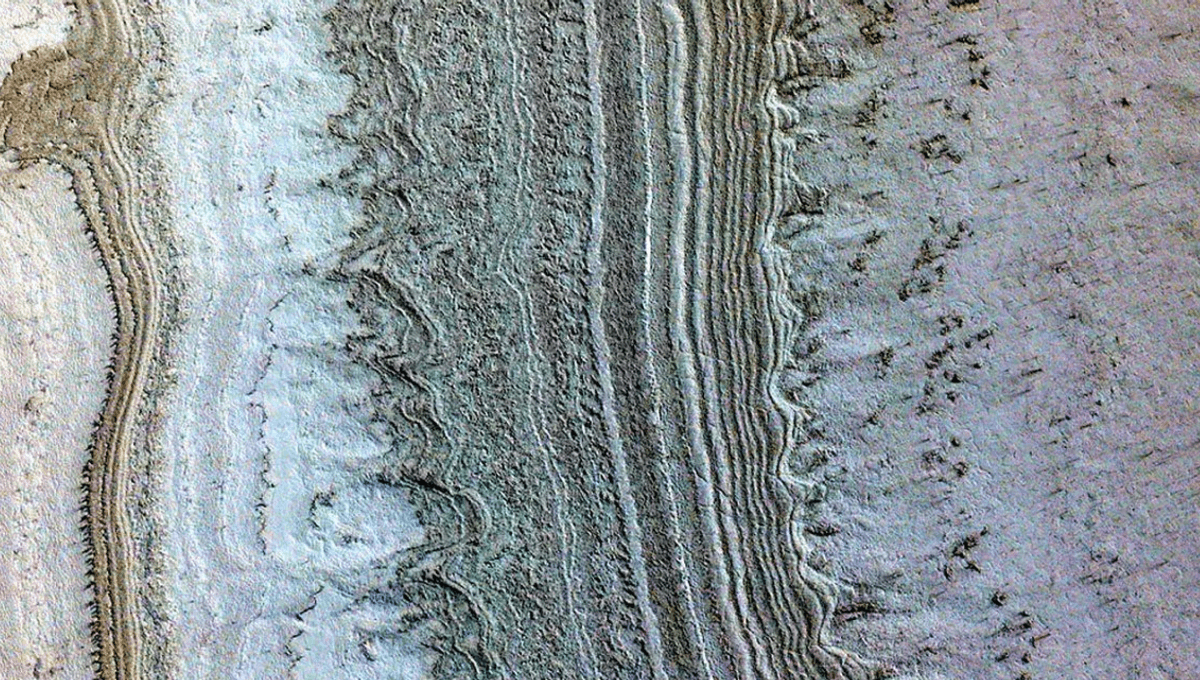
A new explanation has been offered for the reflective signals that were once acclaimed as evidence for a lake of liquid water under the ice sheet at the Martian south pole. Without further data, we cannot definitively state the cause of the reflections– but given what else we know, the exciting idea of a subsurface lake appears exceptionally unlikely.
Liquid water on Mars, even deep underground, would be one of the most thrilling developments possible in the search for extraterrestrial life. We’ve learned the outer solar system is packed with moons with internal oceans, but even getting a spacecraft to fly by them is a slow and expensive exercise, let alone drilling down. Something on Mars would not only be much more convenient, but could preserve a record of the time when an entire ocean existed on the surface.
So the announcement in 2018 of radar reflections coming from under the Martian southern ice cap, which were interpreted as a large buried lake, was the ultimate case of “huge if true” for astrobiologists. Sadly, the if was doing a lot of work. Now it has been shown that layers of ice mixed with dust could produce similar reflections.
The initial reports of a buried lake were based on signals from the Mars Advanced Radar for Subsurface and Ionosphere Sounding (MARSIS) radar bouncing back from 1.5 kilometers (0.9 miles) underground. These reflections spanned an area 20 kilometers (12 miles) across, and the team that discovered them claimed the water needed to make them had to be at least a few centimeters deep. Follow-up work found similar signals more widely.
Subglacial lakes exist on Earth, and the presence of all that protective ice and dust could prevent swift evaporation, as would happen to any water near the Martian surface.
Anything this potentially important is going to be subject to considerable scrutiny. The team that made the finding considered several alternative explanations prior to publication, including a layer of carbon dioxide ice or very cold water ice, but claimed both would produce a weaker signal.
However, according to new analysis, layers of dusty water ice with small variations in composition and layer spacing could cause the radar waves to constructively interfere in ways that match the observations. This sort of interference is usually represented by analogy with water waves passing through two channels in a breakwater,
“I can’t say it’s impossible that there’s liquid water down there, but we’re showing that there are much simpler ways to get the same observation without having to stretch that far, using mechanisms and materials that we already know exist there,” said Dr Daniel Lalich of Cornell University in a statement. “Just through random chance you can create the same observed signal in the radar.”
The presence of water ice on Mars has been known for decades, and rovers have provided evidence for the once-controversial idea that the planet used to be quite wet. Consequently, the idea of a buried lake was not considered out of the question. However, Lalich and colleagues are not the first scientists to raise doubts.
For one thing, Mars is so cold – particularly at the poles – that even deep underground there are doubts water could stay liquid, no matter how salty it is. The more examples of this reflection that were found, the less likely it became that a surviving magma hotspot was providing the warmth required.
Although clays and a revived carbon dioxide ice explanation have been revived as alternatives, neither matches all the data MARSIS and other orbiters have provided, however. Lalich also says previous work relied on fairly simple models of radar behavior on Mars, and that his team has represented reality more closely. They generated thousands of random scenarios for ice layers, all consistent with the conditions we know exist, and changed the composition and spacing of the layers in plausible ways.
When the layers’ spacing was too small for the instrument reading them to resolve, the result was constructive interference, with peaks and troughs amplified. The peaks would appear as bright patches, which could easily be interpreted as subsurface water, the authors concluded. The patches would be distributed randomly compared to the thickness of ice above or subsurface conditions, consistent with the MARSIS data, but surprising if liquid water really was present.
“The idea that there would be liquid water even somewhat near the surface would have been really exciting,” Lalich said. “I just don’t think it’s there.”
The study is published open access in the journal Science Advances.
Source Link: Sadly, That Proposed Lake Under Mars’ Icecap Is Probably An Illusion